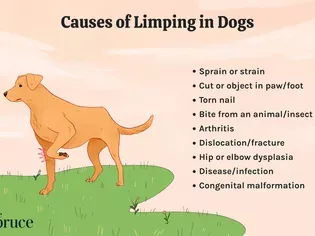Why Is My Dog Limping?
Updated on 05/27/24

Why Is My Dog Limping? A Comprehensive Guide to Causes and Treatment
Limping is a common problem in dogs, and it can be caused by a variety of factors. While some causes of limping are minor and can be treated at home, others can be more serious and require veterinary attention.
If your dog is limping, it is important to determine the cause as soon as possible so that you can begin treatment. To help you do this, we have compiled a comprehensive guide to the most common causes of limping in dogs, as well as tips on how to treat them.
Causes of Limping in Dogs
There are many different factors that can cause a dog to limp. Some of the most common causes include:
* Trauma: This is the most common cause of limping in dogs. Trauma can occur when a dog is hit by a car, falls, or is injured in a fight with another animal.
* Arthritis: This is a common condition in older dogs that can cause pain and stiffness in the joints. Arthritis can be caused by a variety of factors, including genetics, obesity, and injury.
* Hip dysplasia: This is a condition that affects the hip joint. Hip dysplasia can cause pain and lameness, and it can lead to arthritis if it is not treated.
* Patellar luxation: This is a condition that affects the kneecap. Patellar luxation can cause the kneecap to pop out of place, which can be painful and cause limping.
* Tendon or ligament injuries: These injuries can occur when a dog overexerts itself or is injured in an accident. Tendon or ligament injuries can cause pain and lameness, and they can take a long time to heal.
* Bone cancer: This is a rare but serious condition that can cause limping and pain. Bone cancer can be treated with surgery, chemotherapy, or radiation therapy.
How to Treat Limping in Dogs
The treatment for limping in dogs will depend on the underlying cause. Some common treatments include:
* Rest: This is the most important thing you can do for a dog that is limping. Rest will allow the injured tissues to heal.
* Ice: Ice can help to reduce pain and swelling. You can apply ice to your dog's leg for 15-20 minutes at a time, several times a day.
* Medication: Your veterinarian may prescribe medication to help reduce pain and inflammation.
* Surgery: Surgery may be necessary to treat some causes of limping, such as hip dysplasia or patellar luxation.
* Physical therapy: Physical therapy can help to strengthen the muscles and joints around the injured area.
When to See a Veterinarian
It is important to see a veterinarian if your dog is limping for more than a few days, or if the limping is severe. Your veterinarian will be able to diagnose the underlying cause of the limping and recommend the best course of treatment.
Conclusion
Limping is a common problem in dogs, but it is important to determine the underlying cause so that you can begin treatment. By understanding the most common causes of limping in dogs, you can help your dog get back on its feet and feeling better as soon as possible.
Explore More Pets

Basic Training
Puppy and Baby Introductions

Working Dog Breeds
All About Search and Rescue Dogs

Dog Treatments
Puppy Vaginitis: Signs, Causes and Treatment

Dog Adoption
After More Than 1,200 Days in the Shelter, Coco Goes Home

Basic Training
How to Train Your Puppy to Go on Potty Pads

Hybrid Dog Breeds
The Difference Between a Mutt, Mixed Breed, or Designer Dog?

Dog Treatments
Nail Problems in Dogs

Puppies
7 Reasons Why Two Dogs Are Better Than One
